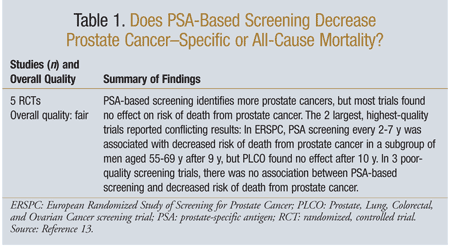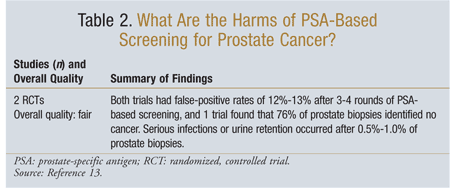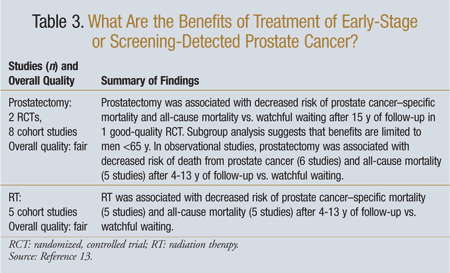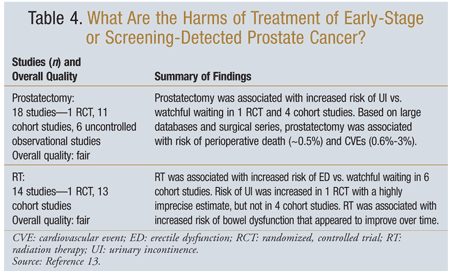US Pharm. 2012;37(6):43-45.
In the United States, prostate cancer is the most common type of cancer in men irrespective of race or ethnicity.1 Earlier detection of prostate cancer through the prostate-specific antigen (PSA) test resulted in an upswing in cases from the mid-1980s to the mid-1990s.2
Until recently, the PSA test was the gold standard as part of physical examinations for men, especially in those older than 50 years of age. As of October 2011, however, the U.S. Preventive Services Task Force (USPSTF) no longer recommends that men older than 50 years routinely receive PSA testing.3 This is because there is no consensus that screening for prostate cancer saves lives, and also because treatment often leads to complications (e.g., impotence and incontinence). As a result, the decision to undergo prostate cancer screening now involves weighing the potential risks and benefits of screening. An active-surveillance approach to deciding when and if treatment is appropriate may also be considered if the cancer is found to be progressing. However, there are lifestyle modifications, such as engaging in vigorous physical activity, that may reduce the risk of advanced prostate cancer.
Background
According to the American Cancer Society (ACS), about 1 in 6 men will be diagnosed with prostate cancer during the course of a lifetime, and about 1 in 36 will die of the disease.4 Most prostate cancers grow slowly, but in some cases progression is quick. In several studies, autopsies of older men who died from other diseases revealed that many of the patients also had undiagnosed prostate cancer.5 According to these studies, as many as 7 to 9 out of 10 patients had prostate cancer by 80 years of age.5 Scientists believe that prostate cancer begins with prostatic intraepithelial neoplasia (PIN)—microscopic changes in the size and shape of prostate cells.
Risk Factors and Warning Signs
It is important to identify men with significant risk factors for prostate cancer. Risk factors include age, race/ethnicity, family history, and classification of PIN. Age is one of the strongest risk factors, with a rapid increase in risk after age 50 years.6 Prostate cancer occurs more commonly in African American men and in men living in North America, northwestern Europe, Australia, and the Caribbean Islands.6 The risk is almost doubled if a man has a brother or father with prostate cancer, suggesting that there is a genetic component.6 The risk of prostate cancer is higher if a biopsy reveals high-grade (abnormal) PIN.2 Some of the warning signs of prostate cancer include difficulty urinating, a weak or interrupted urine flow, erectile dysfunction, pain or discomfort in the pelvic area, and bone pain.7
Screening
Traditionally, prostate cancer screening was recommended to detect the disease at earlier, asymptomatic stages, when treatment might be more effective.3 Two tests are used to screen for prostate cancer. The first test is the digital rectal examination (DRE), in which the physician checks for lumps in the prostate by inserting a lubricated, gloved finger into the rectum. Tumors often grow in the area of the prostate next to the rectum.8 The presence of a hard or even spot may signal prostate cancer. The second form of evaluation is a blood test used to detect the amount of PSA protein circulating in the blood. In general, the higher a patient’s PSA level, the greater the chance that cancer is present.9 Alone or in combination, these tests cannot confer a definitive diagnosis of prostate cancer; in every case, a prostate biopsy is required to make the diagnosis. Other causes of elevated PSA include benign prostatic hyperplasia (BPH), prostatitis, and recent prostate biopsy or DRE.10 Ejaculation or strenuous bicycling also can cause a temporary minor increase in PSA.10 It is important to be aware that PSA levels are low in some early-stage prostate cancers.11
The USPSTF’s Review of Evidence
The USPSTF last reviewed the evidence on prostate cancer screening and made recommendations in 2008. In an effort to update these guidelines, the USPSTF conducted an exhaustive review of randomized trials of PSA-based screening, randomized trials and cohort studies of prostatectomy or radiation therapy versus watchful waiting (using changes in symptoms to decide whether treatment is needed), and large observational studies of perioperative harms.3,12 This review sought to answer four key questions: (1) Does PSA-based screening decrease prostate cancer–specific or all-cause mortality? (2) What are the harms of PSA-based screening for prostate cancer? (3) What are the benefits of treatment of early-stage or screening-detected prostate cancer? and (4) What are the harms of treatment of early-stage or screening-detected prostate cancer? See TABLES 1 to 4 for a summary of the evidence.13




The USPSTF concluded that the PSA test was more likely to lead to a substantial risk than to a benefit. The PSA test cannot differentiate between aggressive and nonaggressive cancers, which may result in many men undergoing needless surgery and radiation that expose them to significant side effects. According to the USPSTF, up to 5 men in 1,000 will die within a month of prostate cancer surgery, and approximately 10 to 70 men will experience dangerous complications.3 At least 200 of every 1,000 men treated with radiation or surgery will experience impotence, urinary incontinence, or bowel dysfunction.3 The USPSTF considers these to be serious risks, considering that its review found that PSA screening has not been proven to save lives.
Other Opinions
The USPSTF has determined that PSA-based screening is associated with detection of more prostate cancers, results in little reduction in prostate cancer mortality, and may lead to harms (related to false-positive test results and subsequent treatment).3 The largest clinical studies the USPSTF has examined so far have not found a statistically significant reduction in deaths from prostate cancer among men who had the PSA test compared with those who did not.
Not all experts agree with the USPSTF’s recommendations, however; many support an approach of active surveillance. This involves closely monitoring for cancer via screening tests at regular intervals and then considering treatment options if test results indicate cancer progression.12
Shortly after the USPSTF released its report, the American Urological Association (AUA) issued a statement in response. The AUA’s stance is that an appropriately interpreted PSA test provides important information concerning the diagnosis, pretreatment staging or risk assessment, and monitoring of prostate cancer patients.14 The AUA recommends that once a diagnosis of prostate cancer is made, the patient should discuss with his urologist whether active surveillance or treatment is appropriate.14 This is because not all prostate cancers require treatment, and not all are life-threatening.14
The ACS also recommends that a patient consult his physician, consider the risks and benefits, and make an informed decision about whether to be screened for prostate cancer.15
Lifestyle Modifications
Even if a patient decides against being screened for prostate cancer, there are lifestyle modifications that can help reduce the risk of advanced or lethal disease. Most older men have prostate cancer, but the type of prostate cancer is what is significant.2 The most promising lifestyle modification to lower the risk of advanced disease is to increase the amount of physical activity. A 2005 study found that older men who engaged in vigorous activities such as jogging, biking, swimming, or tennis had a 70% lower risk of advanced or lethal cancer.16 Even though staying lean does not cut the risk of being diagnosed with prostate cancer, it may decrease mortality.17 A healthy body weight at or before diagnosis is a strong predictor of survival.2 Additionally, the benefits of exercising and losing weight go beyond decreasing the risk of prostate cancer. Studies examining the effect of taking vitamin E, selenium, lycopene, vitamin D, or calcium have conflicting results; therefore, no definitive conclusion concerning the effect of these lifestyle modifications can yet be made.18-22
Conclusion
Because it detects prostate cancer earlier, the PSA test has been routinely performed as part of a man’s physical examination. Based on a comprehensive review of evidence, the USPSTF has concerns about PSA testing and no longer recommends routine screening; however, the AUA and other experts disagree. Patients should discuss the risks and benefits of PSA screening with their physician and make an informed decision.
REFERENCES
1. CDC. Prostate cancer: fast facts. www.cdc.gov/cancer/prostate/basic_info/fast_facts.htm. Accessed February 22, 2012.
2. Center for Science in the Public Interest. Cancer—how to lower your risk. Nutrition Action HealthLetter. January/February 2012:3-7.
3. U.S. Preventive Services Task Force. Screening for prostate
cancer: a review of the evidence for the U.S. Preventive Services Task
Force.
www.uspreventiveservicestaskforce.org/uspstf12/prostate/prostateart.htm.
Accessed February 22, 2012.
4. American Cancer Society. What are the key statistics about
prostate cancer?
www.cancer.org/Cancer/ProstateCancer/DetailedGuide/prostate-cancer-key-statistics.
Accessed February 28, 2012.
5. American Cancer Society. What is prostate cancer?
www.cancer.org/Cancer/ProstateCancer/OverviewGuide/prostate-cancer-overview-what-is-prostate-cancer.
Accessed February 28, 2012.
6. American Cancer Society. What are the risk factors for prostate
cancer?
www.cancer.org/Cancer/ProstateCancer/DetailedGuide/prostate-cancer-risk-factors.
Accessed February 28, 2012.
7. Mayo Clinic. Prostate cancer: symptoms.
www.mayoclinic.com/health/prostate-cancer/DS00043/DSECTION=symptoms.
Accessed February 22, 2012.
8. Memorial Sloan-Kettering Cancer Center. Screening guidelines:
prostate cancer.
www.mskcc.org/cancer-care/screening-guidelines/screening-guidelines-prostate.
Accessed February 22, 2012.
9. National Cancer Institute. Prostate-specific antigen (PSA) test.
www.cancer.gov/cancertopics/factsheet/detection/PSA. Accessed May 1,
2012.
10. Schmitz M. Non-cancerous causes of an elevated PSA. What else can
cause an elevated PSA besides prostate cancer? About.com.
http://prostatecancer.about.com/od/symptomsanddiagnosis/a/psacauses.htm.
Accessed May 1, 2012.
11. The Management of Localized Prostate Cancer: Patient Guide. Linthicum, MD: American Urological Association Foundation; 2008.
12. American Cancer Society. Expectant management (watchful waiting)
and active surveillance for prostate cancer.
www.cancer.org/Cancer/ProstateCancer/DetailedGuide/prostate-cancer-treating-watchful-waiting.
Accessed May 3, 2012.
13. U.S. Preventive Services Task Force. Screening for prostate
cancer. Table 1. Summary of evidence.
www.uspreventiveservicestaskforce.org/uspstf12/prostate/prostatearttab1.htm.
Accessed February 22, 2012.
14. American Urological Association. AUA responds to new
recommendations on prostate cancer screening.
www.auanet.org/content/press/press_releases/article.cfm?articleNo=262.
Accessed May 1, 2012.
15. American Cancer Society. American Cancer Society guidelines for
the early detection of cancer.
www.cancer.org/Healthy/FindCancerEarly/CancerScreeningGuidelines/american-cancer-society-guidelines-for-the-early-detection-of-cancer.
Accessed February 22, 2012.
16. Giovannucci EL, Liu Y, Leitzmann MF, et al. A prospective study
of physical activity and incident and fatal prostate cancer. Arch Intern Med. 2005;165:1005-1010.
17. Cao Y, Ma J. Body mass index, prostate cancer-specific mortality,
and biochemical recurrence: a systematic review and meta-analysis. Cancer Prev Res (Phila). 2011;4:486-501.
18. Klein EA, Thompson IM Jr, Tangen CM, et al. Vitamin E and the
risk of prostate cancer: the Selenium and Vitamin E Cancer Prevention
Trial (SELECT). JAMA. 2011;306:1549-1556.
19. Key TJ, Appleby PN, Allen NE, et al. Plasma carotenoids, retinol,
and tocopherols and the risk of prostate cancer in the European
Prospective Investigation into Cancer and Nutrition study. Am J Clin Nutr. 2007;86:672-681.
20. Kristal AR, Till C, Platz EA, et al. Serum lycopene concentration
and prostate cancer risk: results from the Prostate Cancer Prevention
Trial. Cancer Epidemiol Biomarkers Prev. 2011;20:638-646.
21. Fang F, Kasperzyk JL, Shui I, et al. Prediagnostic plasma vitamin
D metabolites and mortality among patients with prostate cancer. PLoS One. 2011;6:e18625.
22. Albanes D, Mondul AM, Yu K, et al. Serum 25-hydroxy vitamin D and
prostate cancer risk in a large nested case-control study. Cancer Epidemiol Biomarkers Prev. 2011;20:1850-1860.
To comment on this article, contact rdavidson@uspharmacist.com.





